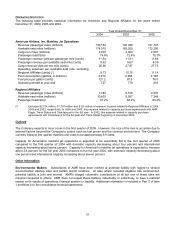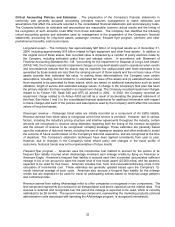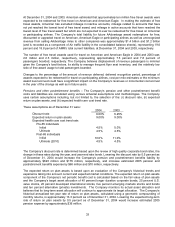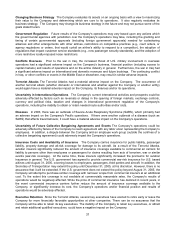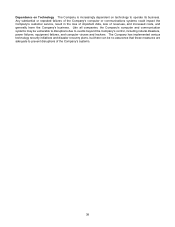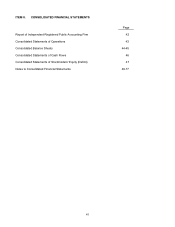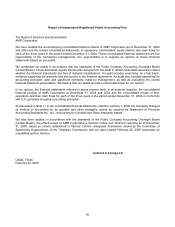American Airlines 2004 Annual Report Download - page 36
Download and view the complete annual report
Please find page 36 of the 2004 American Airlines annual report below. You can navigate through the pages in the report by either clicking on the pages listed below, or by using the keyword search tool below to find specific information within the annual report.
33
At December 31, 2004 and 2003, American estimated that approximately ten million free travel awards were
expected to be redeemed for free travel on American and American Eagle. In making the estimate of free
travel awards, American has excluded mileage in inactive accounts, mileage related to accounts that have
not yet reached the lowest level of free travel award, and mileage in active accounts that have reached the
lowest level of free travel award but which are not expected to ever be redeemed for free travel on American
or participating airlines. The Company’s total liability for future AAdvantage award redemptions for free,
discounted or upgraded travel on American, American Eagle or participating airlines as well as unrecognized
revenue from selling AAdvantage miles to other companies was approximately $1.4 billion and $1.2 billion
(and is recorded as a component of Air traffic liability in the consolidated balance sheets), representing 19.6
percent and 18.8 percent of AMR's total current liabilities, at December 31, 2004 and 2003, respectively.
The number of free travel awards used for travel on American and American Eagle in 2004 and 2003 was
2.6 million and 2.5 million, respectively, representing approximately 7.5 percent and 7.8 percent of
passengers boarded, respectively. The Company believes displacement of revenue passengers is minimal
given the Company’s load factors, its ability to manage frequent flyer seat inventory, and the relatively low
ratio of free award usage to total passengers boarded.
Changes to the percentage of the amount of revenue deferred, deferred recognition period, percentage of
awards expected to be redeemed for travel on participating airlines, cost per mile estimates or the minimum
award level accrued could have a significant impact on the Company’s revenues or incremental cost accrual
in the year of the change as well as in future years.
Pensions and other postretirement benefits – The Company’s pension and other postretirement benefit
costs and liabilities are calculated using various actuarial assumptions and methodologies. The Company
uses certain assumptions including, but not limited to, the selection of the: (i) discount rate, (ii) expected
return on plan assets, and (iii) expected health care cost trend rate.
These assumptions as of December 31 were:
2004 2003
Discount rate 6.00% 6.25%
Expected return on plan assets 9.00% 9.00%
Expected health care cost trend rate:
Pre-65 individuals
Initial 4.5% 5.0%
Ultimate 4.5% 4.5%
Post-65 individuals
Initial 10.0% 11.0%
Ultimate (2010) 4.5% 4.5%
The Company’s discount rate is determined based upon the review of high quality corporate bond rates, the
change in these rates during the year, and year-end rate levels. Lowering the discount rate by 0.5 percent as
of December 31, 2004 would increase the Company’s pension and postretirement benefits liability by
approximately $623 million and $176 million, respectively, and increase estimated 2005 pension and
postretirement benefits expense by $68 million and $10 million, respectively.
The expected return on plan assets is based upon an evaluation of the Company's historical trends and
experience taking into account current and expected market conditions. The expected return on plan assets
component of the Company’s net periodic benefit cost is calculated based on the fair value of plan assets
and the Company’s target asset allocation of 40 percent longer duration corporate bonds, 25 percent U.S.
value stocks, 20 percent developed international stocks, five percent emerging markets stocks and bonds
and ten percent alternative (private) investments. The Company monitors its actual asset allocation and
believes that its long-term asset allocation will continue to approximate its target allocation. The Company’s
historical annualized ten-year rate of return on plan assets, calculated using a geometric compounding of
monthly returns, is approximately 13.3 percent as of December 31, 2004. Lowering the expected long-term
rate of return on plan assets by 0.5 percent as of December 31, 2004 would increase estimated 2005
pension expense by approximately $36 million.










